I n s t r u c t o r ' s S o l u t i o n s M a n u a l
Third Edition
F u n d a m e n t a l s o f
P r o b a b i l i t Y
With Stochastic Processes
SAEED GHAHRAMANI
Western New England College
Upper Saddle River, New Jersey 07458
�
�
C o n t e n t s
1 Axioms of Probability
1.2 Sample Space and Events
1.4 Basic Theorems
1.7 Random Selection of Points from Intervals
2
1
7
Review Problems
9
2 Combinatorial Methods
2.2 Counting Principle
2.3 Permutations
2.4 Combinations
2.5 Stirling’ Formula
Review Problems
16
18
13
31
31
3 Conditional Probability and Independence
35
3.1 Conditional Probability
3.2 Law of Multiplication
3.3 Law of Total Probability
3.4 Bayes’ Formula
46
3.5
3.6 Applications of Probability to Genetics
Independence
41
39
48
56
Review Problems
59
4
Distribution Functions and
Discrete Random Variables
63
4.2 Distribution Functions
4.3 Discrete Random Variables
4.4 Expectations of Discrete Random Variables
4.5 Variances and Moments of Discrete Random Variables
4.6 Standardized Random Variables
66
71
83
Review Problems
83
1
13
35
63
77
�
iv
Contents
5 Special Discrete Distributions
5.1 Bernoulli and Binomial Random Variables
5.2 Poisson Random Variable
94
5.3 Other Discrete Random Variables
99
87
Review Problems
106
6 Continuous Random Variables
6.1 Probability Density Functions
6.2 Density Function of a Function of a Random Variable
6.3 Expectations and Variances
123
Review Problems
111
116
7 Special Continuous Distributions
126
131
7.1 Uniform Random Variable
7.2 Normal Random Variable
7.3 Exponential Random Variables
7.4 Gamma Distribution
144
7.5 Beta Distribution
7.6 Survival Analysis and Hazard Function
147
139
Review Problems
153
8 Bivariate Distributions
152
Joint Distribution of Two Random Variables
Independent Random Variables
8.1
8.2
8.3 Conditional Distributions
8.4 Transformations of Two Random Variables
166
174
Review Problems
191
9 Multivariate Distributions
Joint Distribution of n > 2 Random Variables
9.1
9.2 Order Statistics
210
9.3 Multinomial Distributions
218
Review Problems
215
157
183
200
113
87
111
126
157
200
�
10 More Expectations and Variances
Contents
v
222
10.1 Expected Values of Sums of Random Variables
10.2 Covariance
10.3 Correlation
10.4 Conditioning on Random Variables
10.5 Bivariate Normal Distribution
227
237
239
251
222
Review Problems
254
11
Sums of Independent Random
Variables and Limit Theorems
11.1 Moment-Generating Functions
261
11.2 Sums of Independent Random Variables
11.3 Markov and Chebyshev Inequalities
11.4 Laws of Large Numbers
11.5 Central Limit Theorem
278
282
Review Problems
287
269
274
12
Stochastic Processes
261
291
12.2 More on Poisson Processes
12.3 Markov Chains
12.4 Continuous-Time Markov Chains
12.5 Brownian Motion
Review Problems
326
331
296
291
315
�
�
Chapter 1
A x i om s o f Pr o b a b i l i t y
1.2 SAMPLE SPACE AND EVENTS
j. Clearly, A =
1. For 1 ≤ i, j ≤ 3, by (i, j ) we mean that Vann’s card number is i, and Paul’s card number is
(1, 2), (1, 3), (2, 3)
(2, 1), (3, 1), (3, 2)
(a) Since A ∩ B = ∅, the events A and B are mutually exclusive.
(b) None of (1, 1), (2, 2), (3, 3) belongs to A∪ B. Hence A∪ B not being the sample space
shows that A and B are not complements of one another.
.
and B =
2. S = {RRR, RRB, RBR, RBB, BRR, BRB, BBR, BBB}.
3. {x: 0 < x < 20}; {1, 2, 3, . . . , 19}.
4. Denote the dictionaries by d1, d2; the third book by a. The answers are
{d1d2a, d1ad2, d2d1a, d2ad1, ad1d2, ad2d1} and {d1d2a, ad1d2}.
5. EF : One 1 and one even.
EcF : One 1 and one odd.
EcF c: Both even or both belong to {3, 5}.
6. S = {QQ, QN, QP , QD, DN, DP , N P , N N, P P}. (a) {QP}; (b) {DN, DP , N N}; (c) ∅.
∪
∪
≤ x ≤ 8 1
4
4
x: 8 3
4
≤ x ≤ 9 1
6
.
7. S =
x: 7 ≤ x ≤ 9 1
x: 7 3
8. E ∪ F ∪ G = G: If E or F occurs, then G occurs.
x: 7 ≤ x ≤ 7 1
;
6
4
EF G = G: If G occurs, then E and F occur.
9. For 1 ≤ i ≤ 3, 1 ≤ j ≤ 3, by aibj we mean passenger a gets off at hotel i and passenger b
gets off at hotel j. The answers are {aibj : 1 ≤ i ≤ 3, 1 ≤ j ≤ 3} and {a1b1, a2b2, a3b3},
respectively.
10. (a)
(E ∪ F )(F ∪ G) = (F ∪ E)(F ∪ G) = F ∪ EG.
�
2
Chapter 1 Axioms of Probability
(b) Using part (a), we have
(E ∪ F )(Ec ∪ F )(E ∪ F c) = (F ∪ EEc)(E ∪ F c) = F (E ∪ F c) = F E ∪ F F c = F E.
11. (a) AB cCc;
(b) A ∪ B ∪ C;
(e) AB cCc ∪ AcB cC ∪ AcBCc;
(d) ABCc ∪ AB cC ∪ AcBC;
(c) AcB cCc;
(f) (A − B) ∪ (B − A) = (A ∪ B) − AB.
12. If B = ∅, the relation is obvious. If the relation is true for every event A, then it is true for S,
the sample space, as well. Thus
S = (B ∩ Sc) ∪ (B c ∩ S) = ∅ ∪ B c = B c,
13. Parts (a) and (d) are obviously true; part (c) is true by DeMorgan’s law; part (b) is false: throw
showing that B = ∅.
∞
a four-sided die; let F = {1, 2, 3}, G = {2, 3, 4}, E = {1, 4}.
14. (a)
n=1 An; (b)
37
n=1 An.
15. Straightforward.
16. Straightforward.
17. Straightforward.
18. Let a1, a2, and a3 be the first, the second, and the third volumes of the dictionary. Let a4, a5,
a6, and a7 be the remaining books. Let A = {a1, a2, . . . , a7}; the answers are
x1x2x3x4x5x6x7: xi ∈ A, 1 ≤ i ≤ 7, and xi = xj if i = j
S =
and
x1x2x3x4x5x6x7 ∈ S: xixi+1xi+2 = a1a2a3 for some i, 1 ≤ i ≤ 5
,
respectively.
∞
∞
20. Let B1 = A1, B2 = A2 − A1, B3 = A3 − (A1 ∪ A2), . . . , Bn = An −
n=m An.
m=1
19.
n−1
i=1 Ai, . . . .
1.4 BASIC THEOREMS
1. No; P (sum 11) = 2/36 while P (sum 12) = 1/36.
2. 0.33 + 0.07 = 0.40.
�
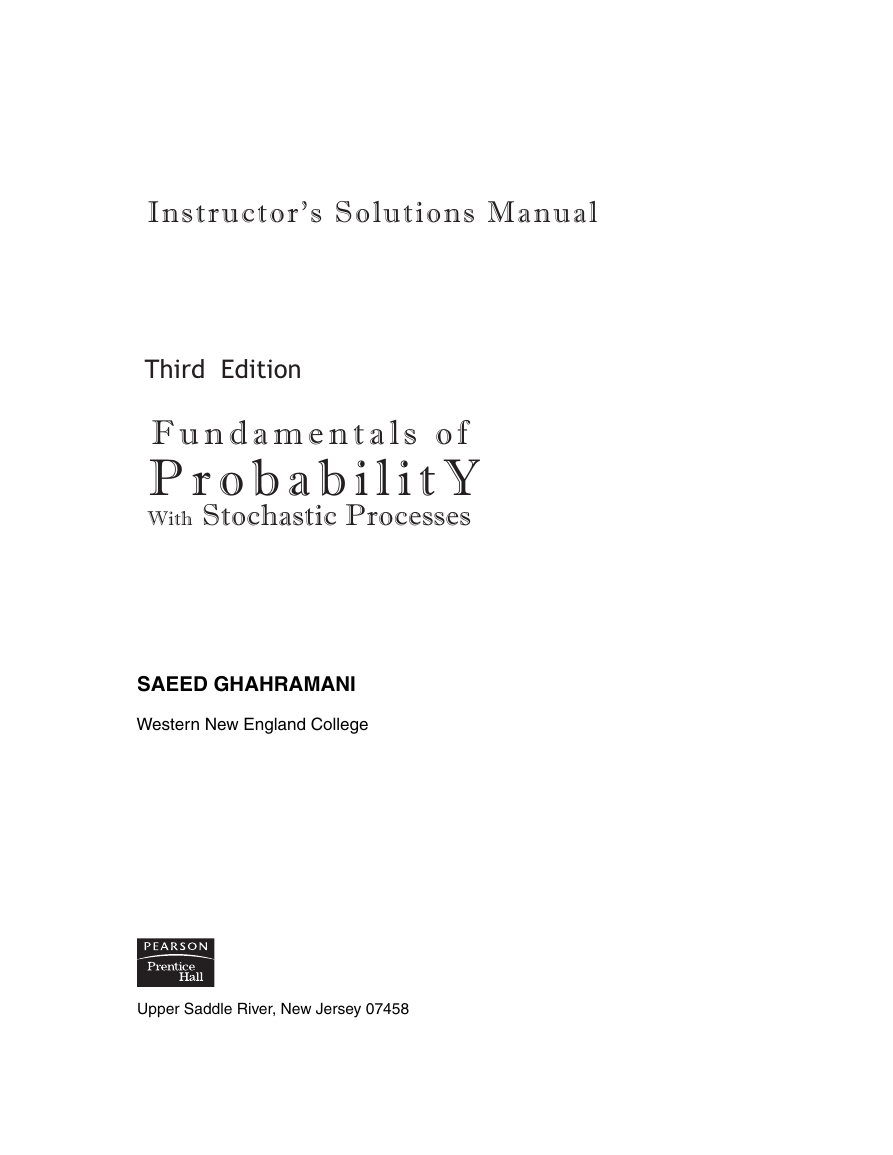

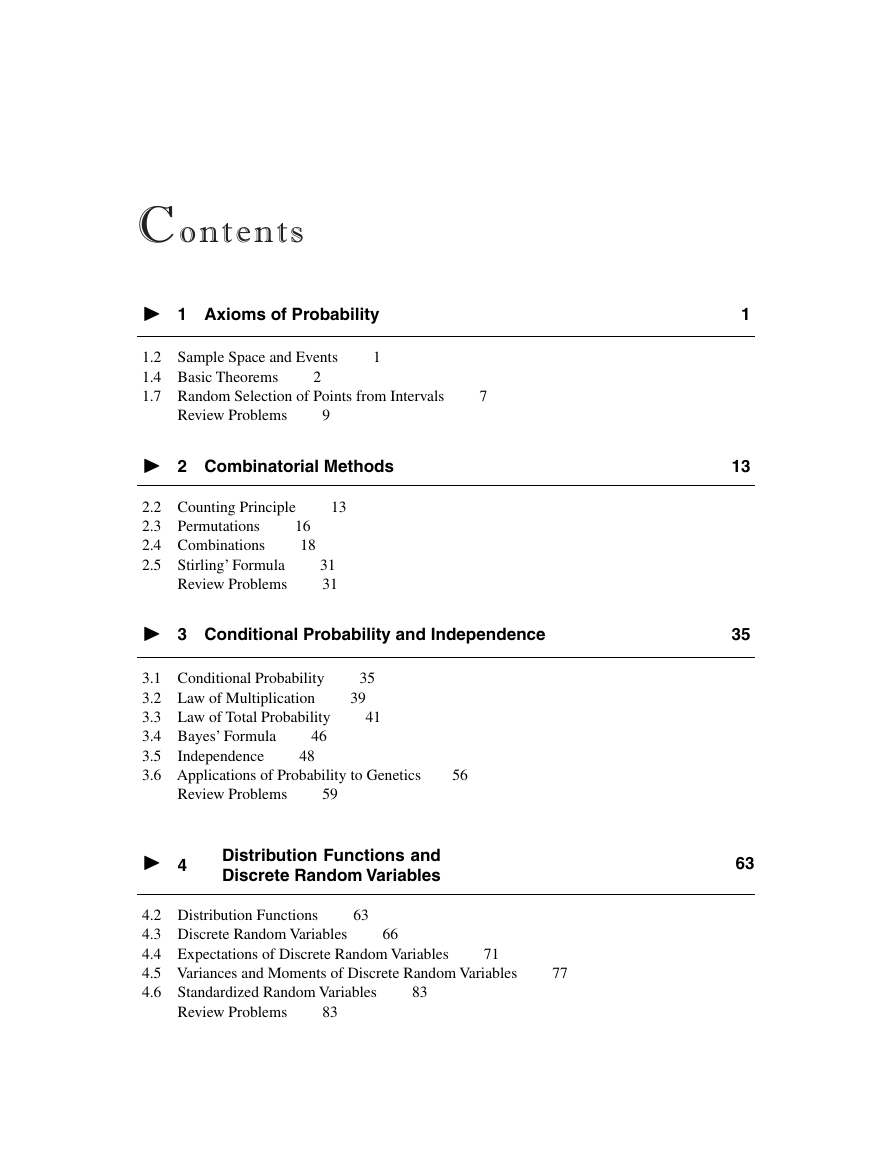
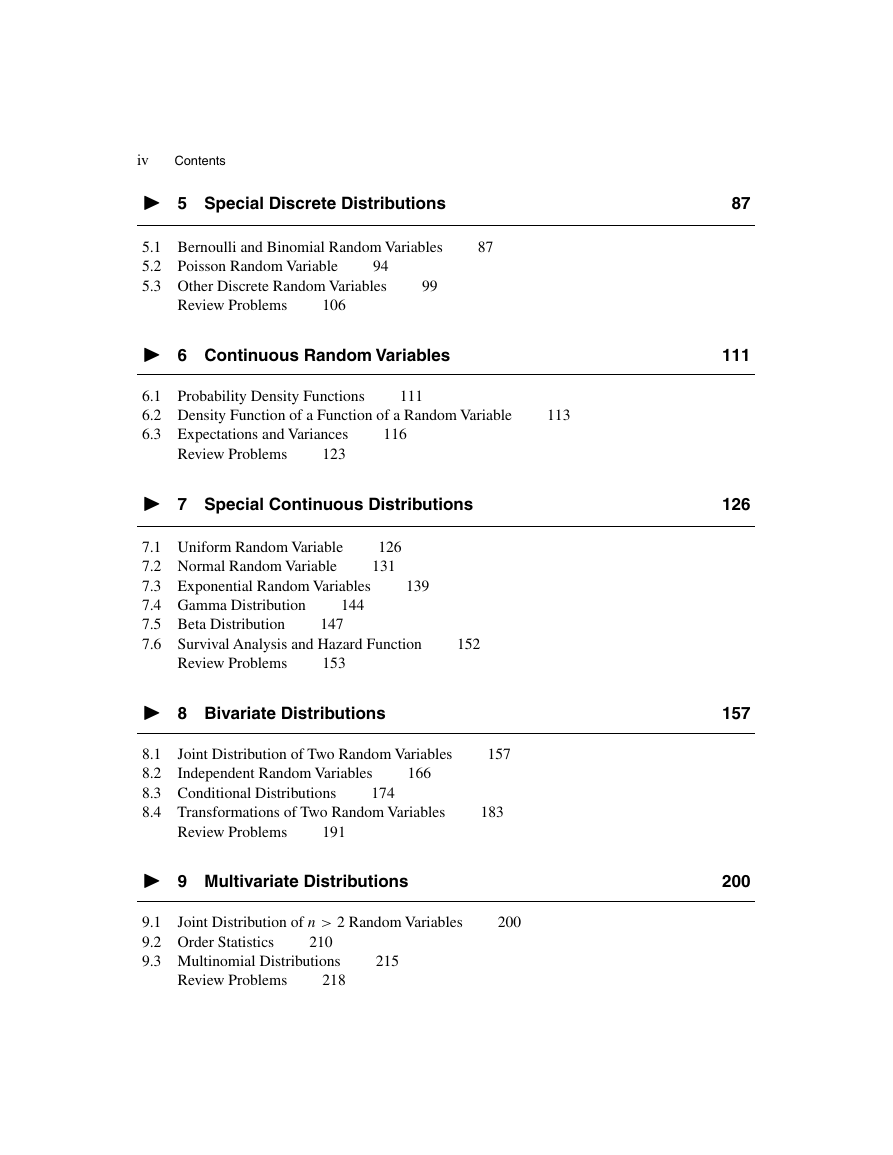
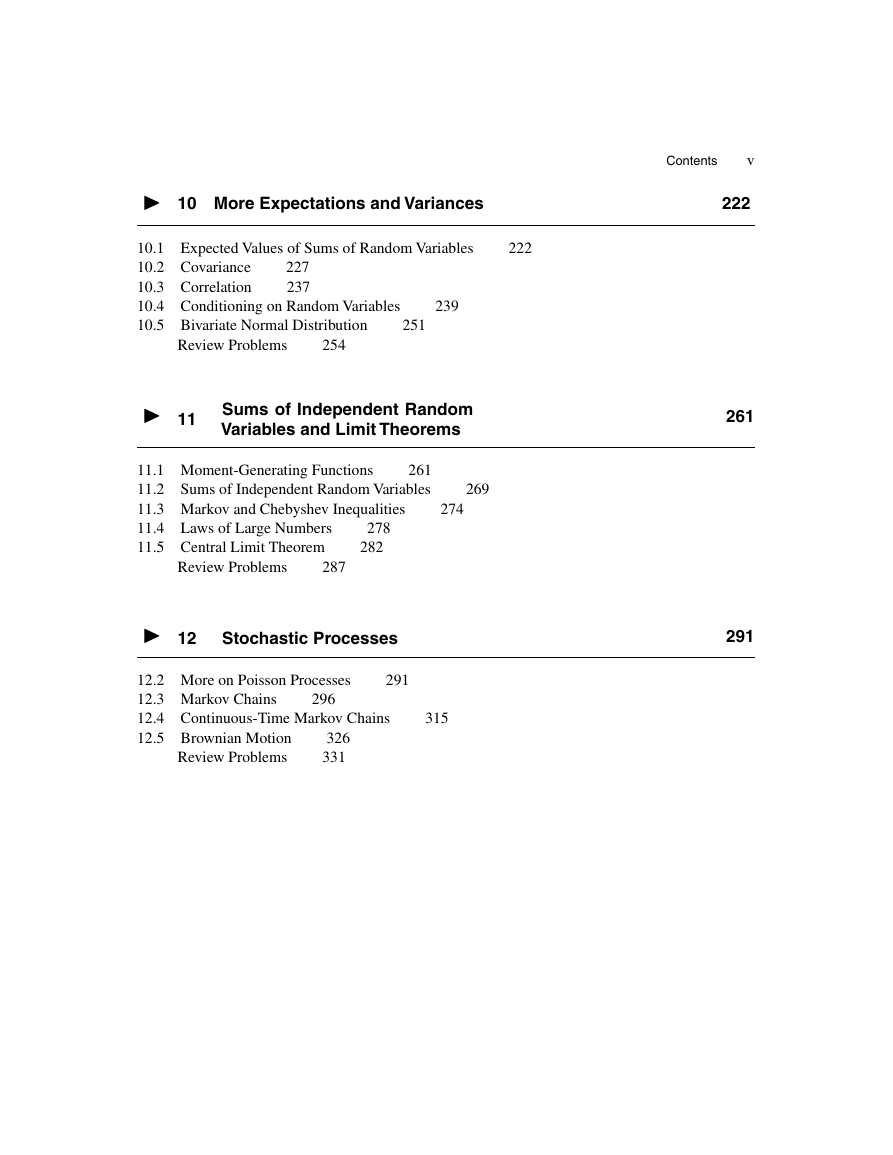

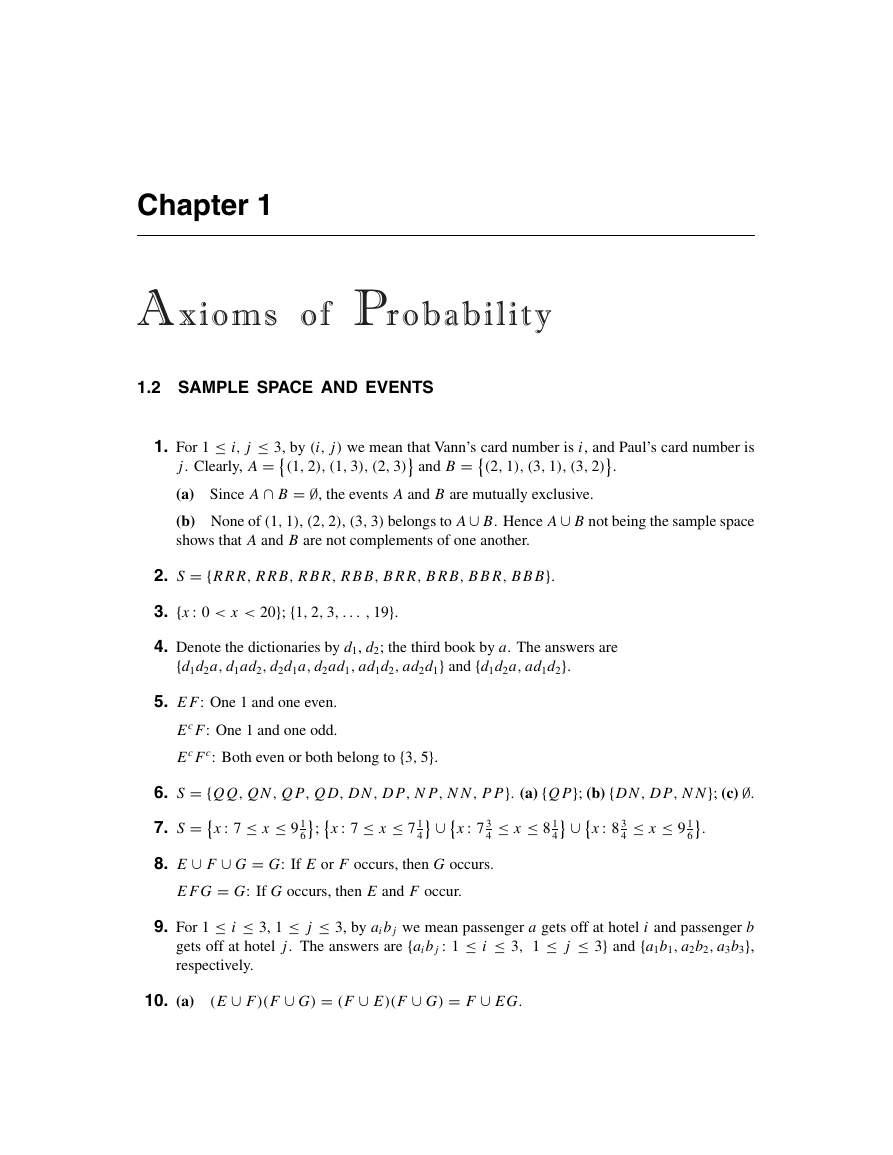









 2023年江西萍乡中考道德与法治真题及答案.doc
2023年江西萍乡中考道德与法治真题及答案.doc 2012年重庆南川中考生物真题及答案.doc
2012年重庆南川中考生物真题及答案.doc 2013年江西师范大学地理学综合及文艺理论基础考研真题.doc
2013年江西师范大学地理学综合及文艺理论基础考研真题.doc 2020年四川甘孜小升初语文真题及答案I卷.doc
2020年四川甘孜小升初语文真题及答案I卷.doc 2020年注册岩土工程师专业基础考试真题及答案.doc
2020年注册岩土工程师专业基础考试真题及答案.doc 2023-2024学年福建省厦门市九年级上学期数学月考试题及答案.doc
2023-2024学年福建省厦门市九年级上学期数学月考试题及答案.doc 2021-2022学年辽宁省沈阳市大东区九年级上学期语文期末试题及答案.doc
2021-2022学年辽宁省沈阳市大东区九年级上学期语文期末试题及答案.doc 2022-2023学年北京东城区初三第一学期物理期末试卷及答案.doc
2022-2023学年北京东城区初三第一学期物理期末试卷及答案.doc 2018上半年江西教师资格初中地理学科知识与教学能力真题及答案.doc
2018上半年江西教师资格初中地理学科知识与教学能力真题及答案.doc 2012年河北国家公务员申论考试真题及答案-省级.doc
2012年河北国家公务员申论考试真题及答案-省级.doc 2020-2021学年江苏省扬州市江都区邵樊片九年级上学期数学第一次质量检测试题及答案.doc
2020-2021学年江苏省扬州市江都区邵樊片九年级上学期数学第一次质量检测试题及答案.doc 2022下半年黑龙江教师资格证中学综合素质真题及答案.doc
2022下半年黑龙江教师资格证中学综合素质真题及答案.doc